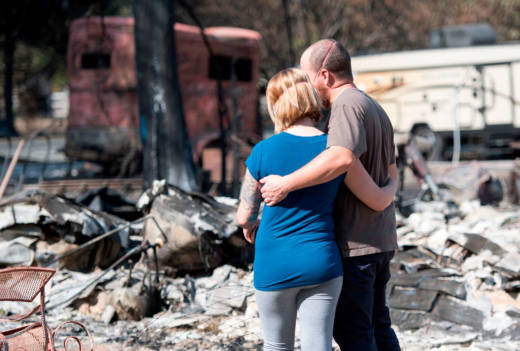Pacific Gas & Electric Co. and its parent company officially filed for bankruptcy protection early Tuesday morning, saying it was necessary as the company tries to deal with tens of billions of dollars in potential liabilities from destructive wildfires in 2017 and 2018.
Though the move just after midnight was expected, reaction was nonetheless swift and overwhelmingly negative. Legislators, experts and consumer watchdog groups slammed the state’s biggest utility, saying it will ultimately benefit the company at the expense of ratepayers and fire victims.
Brad Sherwood, a resident of Sonoma County, said he and his family lost everything but their lives in the Tubbs Fire in 2017. Sherwood, who works for the Sonoma County Water Agency, said he and other survivors are concerned about the news of PG&E’s bankruptcy.
Sherwood said his family was not counting on the utility to help them rebuild, but he is most concerned with what bankruptcy will mean for future wildfire prevention efforts in Northern California.
“Wildfires won't stop because of a bankruptcy. Power, I believe, will still be going through those transmission lines ... fire prevention measures must continue, bankruptcy or not,” said Sherwood. “I think PG&E is behind the ball when it comes to fire prevention measures, and I'm concerned that bankruptcy will further put them behind the ball.”
PG&E Is Filing for Bankruptcy While Still Solvent
At its core, Chapter 11 bankruptcy is aimed at allowing a company to restructure its operations and get rid of some debts when it doesn’t have enough money to pay all those obligations.
But what's unusual about this bankruptcy filing is that the utility is still solvent. As part of its filing, PG&E estimated its liabilities at about $51 billion and its assets at more than $71 billion.
And some critics argue there's no reason for the company to go bankrupt.
“This is the easy way for them to go. This is the way they can move forward and put everyone at risk,” said state Sen. Jerry Hill (D-San Mateo), whose district includes San Bruno, the site of a 2010 gas explosion caused by PG&E equipment.
Hill points out that ratepayers ended up on the hook for billions of dollars in loans after the utility declared bankruptcy in 2001.
“The ratepayers, as we did with the last bankruptcy, will wind up paying a lot more,” he said. “The victims will probably not get dollar for dollar and PG&E will win. They will come out stronger at the end of the day and probably a more profitable company."
Calls for Serious Structural Change at PG&E
Bankruptcy will allow PG&E to reorganize, but some say the changes need to go deeper.
“[The bankruptcy] continues to underscore the need for change at PG&E both in its leadership and corporate culture,” said state Sen. Bill Dodd (D-Napa). “I think what we've got to focus on right now is safety, reliability and affordability of electric power in the state.”

